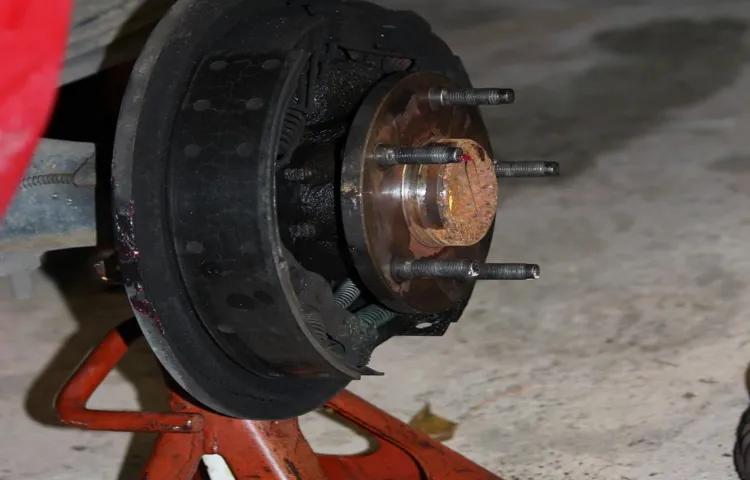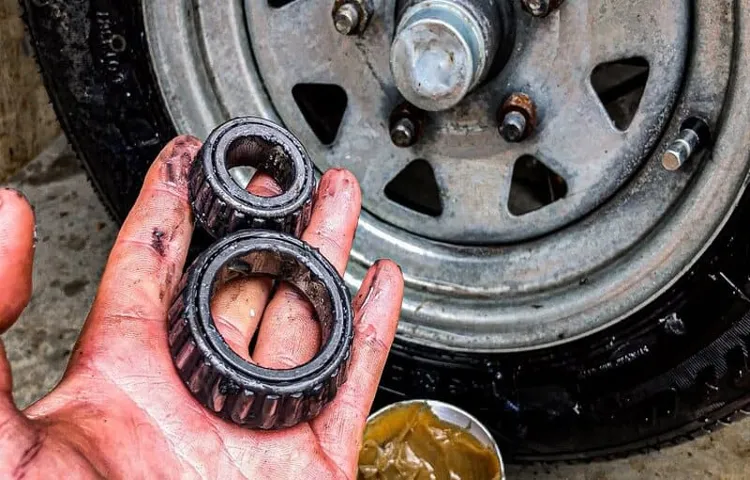Bearing maintenance is essential in ensuring equipment longevity and efficiency. Keeping bearings lubricated and free of wear and tear can save companies thousands of dollars in replacement costs. However, the question on how often to grease a bearing remains a common debate among experts.
Some believe that bearings should be greased at regular intervals, while others argue that this depends on the operating conditions and manufacturer recommendations. In this blog, we will delve deeper into this topic and provide insights on the best practices and factors to consider when greasing bearings. So, let’s get started and explore the fascinating world of bearing maintenance together.
Table of Contents
Understanding Bearings and Grease
If you want to keep your bearings functioning at their best, it’s important to know how often to grease them. The frequency of greasing your bearings will depend on a few factors, such as the type of bearing, its load, and the operating conditions. A good rule of thumb is to grease your bearings every 100 hours of operation, or every three months if you don’t use the equipment regularly.
However, you should also inspect your bearings for wear and tear and adjust the greasing frequency accordingly. Over-greasing can cause excess heat and friction, while under-greasing can cause premature wear and damage. When it comes to choosing the right grease, consult the manufacturer’s recommendations and match it to your equipment’s operating conditions.
With proper maintenance, your bearings can last for years to come.
Types of Bearings
Bearings Bearings are used to reduce friction between moving parts, enabling them to rotate smoothly without wearing down. There are several different types of bearings, including ball bearings, roller bearings, and bush bearings. Each type of bearing works slightly differently and is designed for different applications.
For example, ball bearings are best for applications with low to medium loads and high speeds, while roller bearings are better suited for high loads and low speeds. To keep bearings running smoothly, they should be lubricated with grease. Grease reduces friction and helps to prevent bearings from overheating and seizing up.
Choosing the right type of grease is important, as different types of grease are designed for different applications and operating temperatures. By understanding the different types of bearings and how to properly lubricate them, you can ensure that your machinery runs smoothly and efficiently.

Types of Grease
When it comes to understanding bearings and grease, it’s important to know the different types of grease available. One common type is lithium-based grease, which is versatile and works well in high-pressure environments. Another type is synthetic grease, which is ideal for extreme temperatures and harsh environments.
Calcium-based grease is also common and works well in heavy-duty applications. It’s important to choose the right grease for your specific bearings to ensure optimal performance and longevity. Remember, grease is essential for reducing friction, heat, and wear between your bearings, so choosing the right type will ultimately save you time and money in the long run.
Factors Affecting Grease Frequency
When it comes to maintaining bearings, a common question frequently asked is “how often should you grease a bearing?” The answer depends on several factors that affect lubrication frequency. Factors such as operating temperatures, load capacity, contamination levels, and relative humidity can all impact how frequently bearings require grease reapplication. Typically, bearings operating in extreme environments may require greasing more often than those operating in milder ones.
Moreover, the type of grease used and the bearing’s size and type can also dictate how often bearings should be greased. Generally, it is recommended to grease bearings every six months to a year to prevent any damage from occurring. However, regularly checking the bearings for visual indications of wear and tear and monitoring any noise or vibration during operation can also help determine when a bearing requires additional lubrication to maintain optimal performance.
Load and Speed
When it comes to the frequency of grease application, several factors come into play. One of the most crucial factors that affect grease frequency is load and speed. Heavy loads and high speeds produce more heat, increasing the likelihood of lubricant breakdown, which can lead to equipment damage.
The heavier the load and the faster the equipment rotates, the more frequently it will require lubrication. It is essential to consider the type of grease to use as well since not all greases are suitable for high-speed applications or high loads. Selecting a high-quality grease with the right viscosity and consistency can also help increase the interval between grease applications.
So, when determining how often to grease your equipment, remember to consider the equipment’s load and speed and choose the right grease for the job.
Temperature and Environment
When it comes to the frequency of grease applications, temperature and environmental factors play a major role. Extreme temperatures can cause greases to break down faster, leading to increased wear and tear on machinery. In hotter environments, more frequent grease applications may be necessary to maintain adequate lubrication.
Similarly, high levels of humidity and exposure to moisture can also contribute to the breakdown of grease and require more frequent reapplication. In contrast, cooler temperatures and dry environments may allow for longer intervals between grease applications. It’s important to regularly assess the conditions in which machinery operates and adjust lubrication schedules accordingly to ensure optimal performance and longevity.
So, next time you’re planning your preventative maintenance schedule, consider the temperature and environmental factors that may impact your machinery and adjust your grease frequency accordingly.
Condition of the Bearing
When it comes to maintaining bearings, the frequency at which grease needs to be applied is affected by various factors. The condition of the bearing is a key factor that influences the frequency of grease application. If the bearing is in good condition, it may not require as much grease as a bearing that is worn down or damaged.
Grease frequency can also be influenced by the operating conditions of the machinery. For example, if the machinery is operating in high temperatures or harsh environments, it may require more frequent lubrication. Similarly, if the machinery has high cycle times or is subjected to heavy loads, this can also impact the frequency at which grease is applied.
In order to determine the appropriate grease frequency for a particular bearing, it is important to consider all of these factors and consult with a knowledgeable professional. Ultimately, proper lubrication is essential for ensuring the longevity and performance of bearings, so taking the time to get it right is well worth the effort.
Greasing Frequency Recommendations
If you’re wondering how often you should grease a bearing, the answer depends on several factors. One crucial factor is the type of bearing you have. For example, some bearings may require grease every few months, while others may need lubrication more frequently.
Another significant factor is the application in which the bearing is used. If the bearing is operating in a harsh environment or under heavy loads, it may need to be lubricated more frequently. Ultimately, the manufacturer’s recommendations should be followed, as they know their products better than anyone else.
However, it’s always worth keeping an eye on your bearings and checking for signs of wear and tear – if they appear to be in need of lubrication, it’s better to act sooner rather than later to avoid potential damage. Overall, the key to ensuring long-lasting bearing performance is regular maintenance and lubrication.
Manufacturer Recommendations
When it comes to maintaining factory machinery, one crucial aspect is greasing at the right frequency. Not all machines require the same amount of lubrication, and it’s essential to follow the manufacturer’s recommendations. Manufacturers typically provide guidelines for greasing intervals that consider the type of machine, its usage patterns, and operating environments.
Ignoring these recommendations might cause premature wear and tear, affecting the overall performance and reliability of the machinery. It is also critical to use the right type of grease for each application. Over-greasing can be just as harmful as under-greasing, leading to machinery failure and excessive downtime.
Therefore, it’s essential to follow the manufacturer’s recommendations on greasing frequency and type of lubricant to avoid costly repairs and ensure long-term performance.
Industry Standards
Greasing frequency recommendations. One of the vital aspects of equipment maintenance is ensuring proper greasing. Regular greasing not only increases the lifespan and performance of equipment but also helps avoid costly breakdowns.
The industry standards recommend greasing frequency based on various factors such as the type of machinery, working conditions, and operating temperature. For instance, equipment working in harsh weather conditions or experiencing prolonged operating times might require frequent greasing. Similarly, machinery with high loads and friction might need more lubrication as compared to those operating under lighter loads.
It’s also a good idea to use high-quality greases that match the equipment’s specification to get the maximum benefits out of the greasing frequency recommendations. By adhering to these greasing frequency standards, you can enhance equipment performance and keep it running smoothly.
Conclusion
In conclusion, the question of how often to grease a bearing is like the infamous question of how often to change the oil in your car: it depends. Factors such as the type of bearing, its load and speed, and the environment in which it operates all dictate a unique greasing schedule. Ultimately, a smart strategy is to err on the side of caution and grease more frequently rather than risk damage and downtime.
Remember, well-greased bearings are like well-fed pets; they’ll reward you with a happier, healthier, and longer life. So don’t skimp on the grease – your bearings will thank you!”
FAQs
What are the consequences of not greasing a bearing regularly?
Not greasing a bearing regularly can cause increased friction and heat buildup, leading to wear and tear, and ultimately, bearing failure.
How often should you inspect your bearings for signs of wear?
It’s recommended to inspect bearings every six months or every 10,000 hours of operation to check for signs of wear and tear.
What type of grease should you use for high-temperature applications?
For high-temperature applications, it’s recommended to use a synthetic grease with a high temperature range and good oxidation resistance.
Can over-greasing a bearing be harmful?
Yes, over-greasing a bearing can lead to excessive heat buildup, which can cause the grease to break down and lead to bearing failure.
How can you extend the life of your bearings?
Regular maintenance and inspections, proper lubrication, and keeping bearings clean and free of debris can all help extend the life of your bearings.
What are some common signs of bearing failure?
Common signs of bearing failure include noise (such as grinding or squeaking), vibration, increased heat, and reduced performance.
How do you know if your bearing needs to be regreased?
The best way to determine if a bearing needs to be regreased is to inspect it for signs of wear and tear. However, if there are no obvious signs of wear, it’s recommended to regrease bearings every six months or every 10,000 hours of operation.



